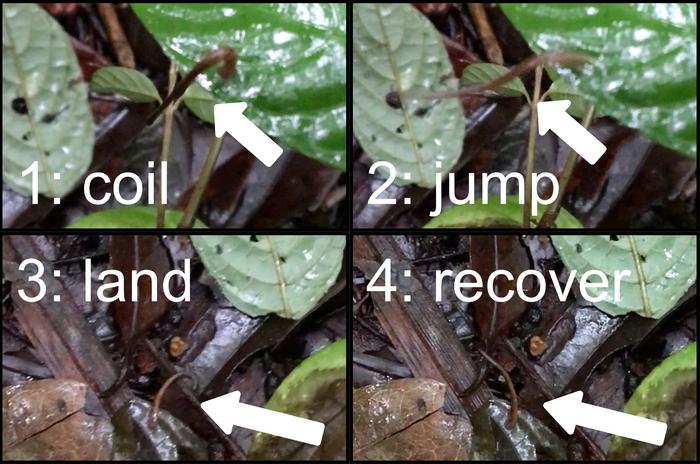Scientists have finally settled a century-old debate with video evidence proving that at least one species of terrestrial leech can jump. The study, published today in the journal Biotropica, was conducted by researchers from the American Museum of Natural History, Fordham University, and City University of New York (CUNY)’s Medgar Evers College.
Lead author Mai Fahmy, a visiting scientist at the Museum and a postdoctoral researcher at Fordham University, recorded footage of leeches from the genus Chtonobdella during two separate expeditions to Madagascar in 2017 and 2023. The video shows the leeches coiling back on a leaf before launching themselves into the air.
“We believe this is the first convincing evidence that leeches can jump and do so with visible energy expenditure,” said Fahmy. “There have been previous accounts of leeches jumping, including onto people, but those reports were often explained away as leeches just attaching to passerby as they brushed against shrubs or dropping from a branch above. This study dispels that argument.”
Leeches Exhibit Unique Jumping Style Compared to Other Invertebrates
Fahmy and coauthor Michael Tessler, an assistant professor at CUNY’s Medgar Evans College and a research associate at the Museum, describe the leech’s jumping motion as resembling a “backbending cobra” or a spring being pulled back. The leech maintains an extended body position as it soars through the air before landing on the ground, which differs from its typical inchworm-like movements.
“Essentially, it executes a graceful jump but with a seemingly hard landing,” Tessler said.
Several other worm-like invertebrates are known to jump, but the ability of terrestrial leeches in the family Haemadipsidae to do so has been a topic of debate among naturalists and leech biologists for years. The leech captured on video during the 2023 trip was identified as Chtonobdella fallax, a common species in Madagascar.
“We do not know how often this may happen or whether these leeches use this ability to seek out hosts, but, given that we caught multiple jumps in two short recordings, this behavior may be common for this species,” said Tessler, who extensively studied leeches as a graduate student at the Museum’s Richard Gilder Graduate School.
The researchers emphasize the importance of understanding leech behavior for conservation efforts, as leeches and their blood meals are increasingly being used to survey vertebrate biodiversity. Fahmy noted that identifying how leeches find and attach to hosts can help better interpret gut content analyses, and that leeches themselves may require conservation protection as a natural part of the ecosystem.
For more information, visit:


